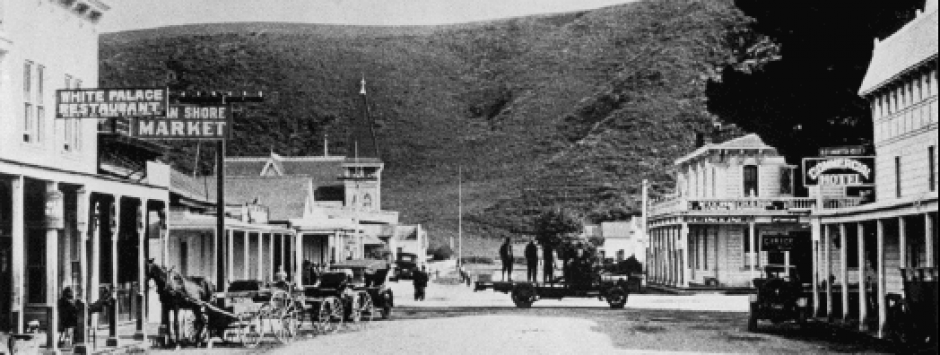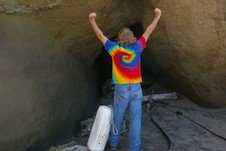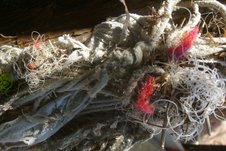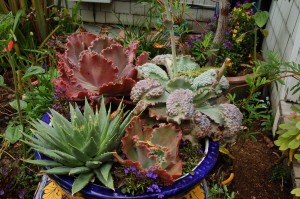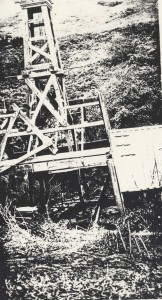HalfMoonBayMemories (HMBM): I remember a huge piece of driftwood; maybe it looked like a fist, but it was very big, and it had been planted in the sands near Ano Nuevo. I always thought of the driftwood as an address and I think a sculptor made the piece of art.
Russell Towle (RT): Well I can’t say for sure but that sculptor sounds like my old friend Merrill Bickford. If so, I was his caretaker. That was my official role while living in that tiny driftwood cabin. And I helped Merrill
build his fine adobe and redwood-bridge-timber house, now a ranger residence. Merrill was amazing. His wife at the time, Janet Creelman, was a mentor of mine, and I named my daughter, Janet, for her.
Merrill once had the pseudonym, or alternate name, Stuart Harwood. It was supposed to be more artistic. His sculptures were displayed at some of the most prestigious museums back East, in the 1950s. In the
1960s he landed at good old Peninsula School in Menlo Park, which is where I met him. The Duvenecks of Los Altos founded the school in the 1920s, classic CA Bohemians.
Merrill was a wild man of many marriages and somehow the alternating names helped him keep clear of past wives. We built a raft sixty feet long and thirty feet wide on the little lake on their Año Nuevo property, the frame was of discarded 6-inch iron irrigation pipes fromthe Rossi’s adjacent artichoke and brussel sprouts fields. Merrill had a huge crew of hippies working for him at that time. I was the welder, he taught me how to do it. We’d take a length of pipe, sledge-hammer each end flat, and then weld it shut. As it turned out these pipes ended up leaking an taking on water, but we stuffed all kinds of rigid foam and so on under the thing and it floated well enough, with a wooden frame atop the iron pipes, and plywood deck.
Upon that deck we erected a 40- by 20-foot greenhouse, installed a wood stove, and there Janet and Merrill lived for two or three years while we finished the Big House, which was not so big. But impressive,
with its ancient redwood timbers, adobe walls, tile roof and tile floors, and sculptural driftwood cabinets and finishing touches.
But the greenhouse was quite magical. The eternal northwest wind kept it rocking and bumping about gently, on its raft, and we could hear the waves thundering on the beach, more than a quarter mile away. It
was at one end of my bird-watching reservoir. Canoes tied up to one end of the raft. We had a little floating sauna I built at one end, made from eleven ancient redwood doors from Coastways Ranch. Willows and tall tules and cattails almost surrounded the greenhouse. It was amazing. No running water, no electricity. A wood stove for cooking. Merrill was a great raconteur and I heard many stories of his fabled life in that greenhouse. In WWII in the Pacific, he was a SeaBee, bulldozing out landing fields for aircraft on remote tropical island paradises. Returning to California after the war, he became a building contractor in the San Diego area, and managed to cut off one of his fingers with his power saw, late one afternoon, in an exhausted hurry.
Meta
Recent Comments
- Dave Olson on About June Morrall
- Gerd Gunkel on About June Morrall
- Ed Holloway on About June Morrall
Categories
- "Mountain" Mike Merritt (6)
- "The Loop" (1)
- A La California: Sketches of Life in the Golden State (3)
- Acid Beach (5)
- Alexander Moore (1)
- AM Parker (2)
- AMB Beach (3)
- Angelo Misthos (5)
- Ano Nuevo (22)
- Ano Nuevo Island (1)
- Ano Nuevo lighthouse (1)
- Arches (3)
- Ashaleigh Parker (2)
- Atlantis Rising (1)
- Bathhouse Rock (1)
- Beach Clean-Up (2)
- Bean Hollow (2)
- Beat Museum (1)
- Bideawee (1)
- Bob Dougherty (1)
- Bobbi Ballard Pimentel (2)
- Buoys (1)
- Burney J. Le Boeuf (1)
- Burt Blumert (1)
- California Coastal Records Project (1)
- California Newspaper Project (1)
- California State Auto Association (1)
- Carrier Pigeon Point (2)
- Cascade Ranch Dairy (2)
- Charles Clark (1)
- Charles F. Humphrey (1)
- Charles Jones (1)
- Charles Swanton (1)
- Chicken's Roost (1)
- clusters (2)
- Coast Survey Maps (1)
- Coastside Arches (2)
- Coastside Beaches (1)
- Coastside Caves (1)
- Coastside Secret Beaches (5)
- Coastside Waterfalls (1)
- Coburn Mystery (14)
- Coburn Troley Co. (1)
- Colombia (4)
- Colonel Albert S. Evans (4)
- Colonel Zig Zag (1)
- Connie Morgan (1)
- Coya British Bark (1)
- Dan Mosier (1)
- Daniel Boone (1)
- Daniel Durigan (1)
- Dave Cline (1)
- Dave Holleman (1)
- Davenport (2)
- David Gremard Romero (1)
- Downey Harvey (1)
- Dr. Alan Brown (2)
- Dr. Carl Djerassi (1)
- Dr. Isaac Goodspeed (1)
- Dr. W. J. Marsh (1)
- Duarte's Tavern (1)
- Eadweard Muybridge (1)
- Edward Mullen (2)
- Eli D. Moore (2)
- Ezra Pound (1)
- Fireman Collins (1)
- Forget-Me-Not Barkentine (1)
- Fourth of July (1)
- Franklin Point (2)
- Fremont Older (1)
- Friends of the Calamari (1)
- Galen Wolf (1)
- Gary Gates & Friends (1)
- Gazos Creek (6)
- Geocaching (1)
- Ghost Net (1)
- Giant Limpets (1)
- gooseneck barnacles (1)
- Gordon's Chute (3)
- Guadalupe Fur Seal (1)
- Harvey Mowry (3)
- Hellespoint Shipwreck (1)
- Hen Frigates (2)
- Henry Blomquist (1)
- Henry Cowell (1)
- Historic Bottles (1)
- Hole in the Wall (2)
- Holes in Pescadero (1)
- Ida J. Steele (1)
- Invisible Beach (12)
- Isaac Graham (1)
- J. W.Seaver (1)
- Jan "the beeman" Snyder (1)
- Jane Schlager (1)
- Janet Creelman (1)
- Jerry Cimino (1)
- Jim Denevan (1)
- Jo Lysowsky (1)
- Joan Druett (2)
- JoAnn Semones (2)
- Joaquin Miller (1)
- Joel Bratman (2)
- John McCormick (1)
- John Morrall (1)
- John Schamle (1)
- John Vonderlin (171)
- Jon Boxerman (1)
- Josiah P. Ames (1)
- Judge Horace Templeton (1)
- Judge James T. O'Keefe (1)
- June Morrall (6)
- Kathy Duarte (1)
- Ken Fisher (1)
- Ken Kesey (6)
- Kings Mountain (1)
- Kristina Schmale (1)
- La Honda (6)
- Lake Lucerne (1)
- Larry (1)
- Larry Fitterer (8)
- Larry Witham (1)
- Laura Wall Taylor (1)
- Leah Lubin (1)
- Lemuel Coburn (1)
- Levy Brothers (7)
- Linda Wyatt Iacono (1)
- Lizzie McCormick (4)
- Lobitos (2)
- Loma Mar (1)
- Loren Coburn (3)
- Lou Denny Wayne (2)
- Mammoth Rocks (1)
- Manuel Chorro (1)
- Marty McCormick (1)
- Mary Florey (1)
- Merrill Bickford (2)
- Message in a bottle (1)
- Michael Bowen (1)
- Michael Head (1)
- Mike Merritt (2)
- Minot Judson (1)
- Molly Ramolla (1)
- Monty Parker (8)
- Myrtle Garavanta (1)
- Mystic Cowboy (1)
- Neal Cassady (1)
- Neptune's Vomitorium (6)
- Notrocks (1)
- Nunziati Dam (1)
- Ocean Shore Railroad (7)
- Oil (4)
- Omar N. Steele (3)
- Orril Fluharty (4)
- Orrin Brown (1)
- Outstandinginthefield (1)
- Pacific City/Coyote Point (1)
- Pacific Mail Carrier Peru (1)
- Palmer Gulch Trestle (1)
- Pebble Beach Hotel (2)
- Pebble Beach Poetry (1)
- Pescadero (26)
- Pescadero Architecture (3)
- Pescadero Hgh School (1)
- Pescadero Historical Society (2)
- Pescadero Oral History Project (1)
- Pescadero Trivia (1)
- Pescadero's Pebble Beach Hotel (3)
- Pigeon Point (3)
- Pigeon Point Lighthouse (13)
- Place Names of San Mateo County (2)
- Pomponio (2)
- Pomponio Creek (1)
- Princeton-by-the-Sea (1)
- Prohibition (6)
- Purisima Falls (2)
- Purple People Eaters (1)
- Pyramids (2)
- Ralph E. Wall (1)
- Redwood Trees (2)
- Rennesselear Steele (1)
- Richard Ledford (2)
- Rob Tillitz (2)
- Robin Caldwell (3)
- Ron Duarte (2)
- Russell Towle (23)
- Samuel Bean (1)
- San Francisco Call (1)
- San Gregorio (3)
- San Juan (3)
- San Mateo County History Museum (1)
- Sarah Coburn (1)
- Sarah Swanton (1)
- Sawmills (1)
- Sea Monster (1)
- Sea Serpents (1)
- Shawn Mann (1)
- Sheri Martinelli (2)
- Sir John Franklin (1)
- Smuggler's Cove (1)
- Snails (1)
- South Coast beaches (6)
- South Coast Brick (1)
- South Coast Tunnels (4)
- Spaulding Corner (1)
- SS Fremont (1)
- Stacy Trevenon (1)
- Steele Family (6)
- Storm 1998 (1)
- Susan Friedman (3)
- Swanton House (1)
- Tafoni (1)
- Tarballs (1)
- Terry Adams (3)
- Tess Black (3)
- The Butano (7)
- The Contender (4)
- The Gazos (1)
- The Notch (1)
- The Pollocks (1)
- The Quest (3)
- The Seven Sisters (1)
- The Wrack (2)
- Thomas Butwell (1)
- Tires (2)
- Tom Butwell (1)
- Torquay (2)
- Trefiret Beach (1)
- Tunitas Creek (9)
- Uncategorized (412)
- Upenuf Road (1)
- Vanishing Beaches (1)
- Vulcan's Donut (1)
- Wadell Beach Bypass (1)
- Warm Water Lagoon (4)
- Whale Fall (1)
- Whale Watching (1)
- whaling (2)
- William Steele (1)
- Willowside Dairy (2)
- WJ Savage (1)
- Worm Farm (2)
- WWII Coastside (2)
